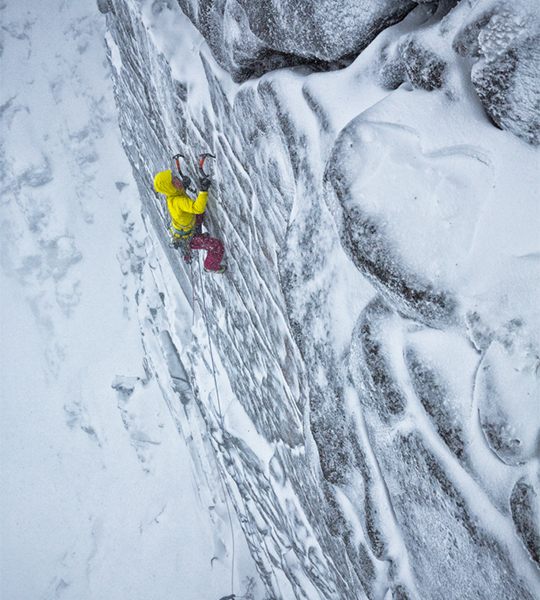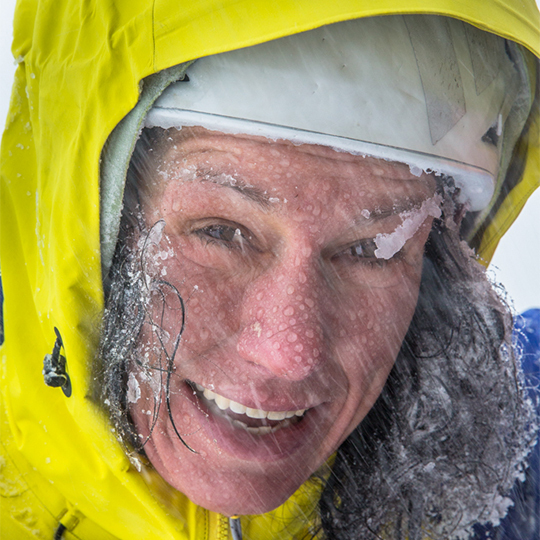
[Photo] Nadir Khan
The wind travels like a thundering train, snaking around the frosted glacial cirque of Coire an t-Sneachda in the Cairngorm Mountains of Scotland. Unpredictable gusts threaten to knock the climber Ines Papert off her tenuous stance, high on the cirque’s exposed Fiacall Buttress. The falling snow quickly turns into sharp ice pellets, stinging skin and plastering every crevice of the vertical wall, hiding what small placements the route allows.
Visibility closes in. There is no ice to swing a tool into securely, only rime-choked cracks and a jigsaw puzzle of seams that spit out gear. Papert breathes and continues. A few millimeters of crampon steel touch a tiny snow-covered edge. She reaches long, and an ice tool finds a small hook. Then it pops. Papert’s feet skate. She hangs straight-armed off a single tool high on the thirty-five meter pitch, an E4 6a in summer, but in winter a heady XI 11 (M9/M10). Papert reattaches her feet to the wall and continues up into the storm, making, on February 22, the fifth-ever winter ascent of the climb.
Papert had sussed out and attempted The Hurting two days prior to her successful lead. Unwilling to risk a ground fall on the sparsely protected lower terrain, she approached from above and rappelled five meters right of the line to inspect protection options. “I wasn’t planning an onsight of The Hurting,” she tells Alpinist. “I just wanted to check out some gear placements at the very bottom, which I knew were sketchy.” She decided not to practice any moves on toprope before her first lead attempt.
“I pulled the ropes and led the route [while belayed by Seppi Pfnuer], taking two falls–one onto a Pecker on the sequence below the roof, one onto a cam on the upper wall,” she says. “Seppi seconded the route, removing all the gear.” By the time he reached the top he had lost feeling in his fingers.

[Photo] William M. Connolley
The Scottish climber Dave MacLeod established the The Hurting as a mixed climb in February 2005, after abseil inspection and after having fallen three moves from the top on a flash attempt; at the time, this smooth, vertical buttress was considered the hardest single-pitch traditional mixed climb in the world. The route is sustained from bottom to top. As MacLeod describes on scottishclimbs.com, “The climbing is hooking rounded edges, tiny torques, tufts of turf and undercutting…Then a thin hooking wall leads to a roof. The next section is burly lay backing through the summer crux crack followed by a culmination on the last few moves of thin wall climbing.”
When Papert and her partner for the day, Simon Yearsley, set out on February 22, weather conditions did not look promising. “Even though the cracks were white and there was snow on all the ledges, looking back, the overall feel of the route wasn’t wintery enough,” Papert told ukclimbing.com. Now in a full winter storm, Yearsely persuaded her to leave the decision-making until they reached the base. He thought there was a chance they would be sheltered from the wind. Once there, however, they were fully exposed to 80-plus-mile-per-hour gusts coming from all directions. Papert set out. “I’ve been climbing for over 35 years, and this was the most impressive lead I’ve ever witnessed,” Yearsley told ukclimbing.com. “Ines’s ascent of The Hurting was extraordinary in the fullest sense of the word,” echoes Simon Richardson, owner of scottishclimbs.com. It’s perhaps fitting that Papert climbed The Hurting in the same “full conditions” as McLeod.

[Photo] Stuart Cankett
Fierce winds batted her from side to side, threatening to blow her off rounded smears while she picked at the the snow- and rime-ice-covered cliff, Yearsley reports. Papert worked through sketchy moves from the start with “a couple of bits of poor gear until a secure and comfortable sling.” The next moves involved “a tenuous traverse before a dubious hex,” Yearsley says. As Papert climbed a little above the traverse, a sudden gust caught the sling runner and blew it clean off. “The first ten meters felt kind of challenging, until I got the first good gear in,” Papert says. “The crux, getting over the roof, felt quite good and safe, but the upper wall was super technical.” She made it to the anchors on her first attempt of the day. Adding to the challenge, she says “none of the gear from the previous day was possible. [Everything looked] different with the ice and snow in the cracks.”

[Photo] Nadir Khan
Papert is a four-time winner of the World Ice Climbing Championships and multi-time winner of Ouray Ice Festival. She had made notable first ascents including Power of Silence (400m, 5.13a, 11 pitches), Cirque of the Unclimbables, Canada; Quantum of Solace (ABO, WI 7+, M7), Great Walls of China, Himalaya; Northwest Face (5.11+ A1, 1200m) of Mt. Asgard’s South Tower, Baffin Island; the previously unclimbed Himalayan Peak Likhu Chuli (6719m); and most recently the first repeat of Ritter Der Kokosnuss (M12, WI5), at the Breitwangflue at Kandersteg in Switzerland.
“What I learned on [this] trip is only attempt a route when it is in really good winter conditions, the rock is covered in white rime, well-frozen vegetation, and there is a ‘wintery’ feel to the route,” Papert says. This was her third climbing trip to Scotland.
In related news, the Scottish climber Greg Boswell on February 25 made the first ascent of Banana Wall XII, 12 at Coire an Lochain, also in the Cairngorm Mountains. Boswell had originally attempted this very overhanging mixed buttress in December 2013, but backed off after eight meters because the climb, he blogged, looked “too god damn hard.” Boswell made another attempt earlier in the 2014/2015 season, but again down climbed at the same height, unable to discern reliable protection options above. He then opted for a rappel inspection, but, he wrote “The second you have left the belay (rapp point) you are in space and free hanging, and despite placing a few pieces of marginal gear to keep me in a bit, it was obvious that I was going to get nowhere near my climbing high-point to see if there would be any protection to aim for.”
On February 25, with Masa Sakano, Boswell returned for the lead. This time he pushed through a crux bulge/roof and into a blanker section above. Boswell climbed higher, fighting for protection, ever more exhausted, when his axe popped and he took a ten-meter fall. On his next go, high on a steep headwall above the radically overhanging lower terrain and far from his last runner, Boswell engaged a “heart in mouth sequence of thin hooks and shallow torques” to reach the belay ledge. The climbers completed one more pitch to the top of the crag in strong winds, in the dark, with only one headlamp between them. On his blog, Boswell wrote that Banana Wall’s crux terrain felt like M11, and has proposed the rare grade of XII/12. Meanwhile, the gear, he was quoted as saying, is “there if you’re fit!”
To learn more about Papert, read the excerpt Falling from her book Im Eis on alpinist.com.